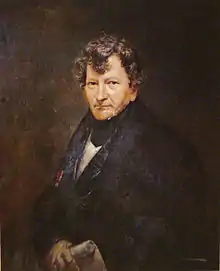1850 in architecture
The year 1850 in architecture involved some significant architectural events and new buildings.
| |||
|---|---|---|---|
Buildings and structures
|
Events
- November 1 – Foundation stone laid for church of All Saints, Margaret Street, London, designed by William Butterfield. supervised by Beresford Hope for the Cambridge Camden Society as a model of the High Victorian Gothic ecclesiological style.
Buildings and structures
Buildings completed

Sainte-Geneviève Library reading room
- Bratsberg Church, Trondheim, Norway.[1]
- Hillsgrove Covered Bridge, Pennsylvania, USA.[2]
- Britannia Bridge in North Wales, engineered by Robert Stephenson, is opened.
- Newcastle railway station in the north-east of England, designed by John Dobson, is opened.[3]
- Sainte-Geneviève Library in Paris, designed by Henri Labrouste, is completed, the first major public building with an exposed cast-iron frame.[4]
- Château de Boursault, France, designed by Jean-Jacques Arveuf-Fransquin.
- Peckforton Castle, England, designed by Anthony Salvin.
- Vĩnh Tràng Temple, Mỹ Tho, Vietnam.[5]
Awards
- Grand Prix de Rome, architecture – Victor Louvet
- RIBA Royal Gold Medal – Charles Barry
Births
- January 10 – John Wellborn Root, Chicago-based US architect (died 1891)
- February 17 – Frank Darling, Canadian architect associated with Toronto (died 1923)
- November 15 – Victor Laloux, French Beaux-Arts architect and teacher (died 1937)
- December 21 – Lluís Domènech i Montaner, Spanish-Catalan architect, a leader of Modernisme català, the Catalan Art Nouveau/Jugendstil movement (died 1927)
- Robert Worley, English architect (died 1930)
Deaths
- February 19 – François Debret, French architect (born 1777)
- March 2 – Auguste-Henri-Victor Grandjean de Montigny, French architect influential in Brazil (born 1776)
- May 8 – Antonio Niccolini, Italian architect, scenic designer, and engraver (born 1772)[6]
- July 12 – Robert Stevenson, Scottish lighthouse engineer (born 1772)
- September 5 — John Holden Greene, American architect based in Providence, Rhode Island (born 1777)
References
- "Bratsberg kirke" (in Norwegian). Strinda historielag. Retrieved 2011-04-15.
- "Pennsylvania Cultural Resources Geographic Information System". Pennsylvania Historical and Museum Commission; Pennsylvania Department of Transportation. Archived from the original (Searchable database) on 2007-07-21. Retrieved 2011-01-12.
- Biddle, Gordon; Nock, Oswald (1983). The Railway Heritage of Britain. London: Michael Joseph. ISBN 0-7181-2355-7.
- Trachtenberg, Marvin; Hyman, Isabelle (1986). Architecture: from Prehistory to Post-Modernism – the Western tradition. London: Academy Editions. p. 478. ISBN 0-85670-899-2.
- Võ Văn Tường. "Các chùa Nam Bộ" (in Vietnamese). Buddhism Today. Retrieved 2008-05-30.
- Cassanelli, Roberto; Ciapparelli, Pier Luigi; Colle, Enrico; David, Massimiliano (2001). Houses and Monuments of Pompeii: The Work of Fausto and Felice Niccolini. p. 23. ISBN 9780892366842.
This article is issued from Wikipedia. The text is licensed under Creative Commons - Attribution - Sharealike. Additional terms may apply for the media files.
